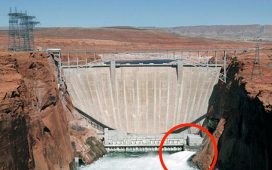
Nasa has switched on an atomic clock that could one day change the way we explore the distant universe.
The Deep Space Atomic Clock has been successfully activated and will now stay on for a year to check that the technology powering it works, the space agency has announced.
If the test is successful, the clock will allow spacecraft to navigate themselves through space, rather than relying on the long and difficult process of being guided by messages from Earth.
That in turn could allow for spacecraft to fly further from the Earth, into deep space and exploring the far-away universe. From there, astronauts might be able to travel to the rest of the solar system and into deep space.
The new clock is the first timekeeper that is stable enough to be used to map a spacecraft’s trajectory through deep space, while also being small enough to fit onboard that same spacecraft.
1/10
“When stars like the Sun grow advanced in age, they expand and glow red. These so-called red giants then begin to lose their outer layers of material into space. More than half of such a star’s mass can be shed in this manner, forming a shell of surrounding gas. At the same time, the star’s core shrinks and grows hotter, emitting ultraviolet light that causes the expelled gases to glow.
This type of object is called, somewhat confusingly, a planetary nebula, though it has nothing to do with planets. The name derives from the rounded, planet-like appearance of these objects in early telescopes” – European Space Agency
Nasa
2/10
Two galaxies are seen interacting with one another. This pair of galaxies is known as UGC2369 and they are being drawn together by mutual gravitational attraction. Our own Milky Way galaxy is next expected to interact with another galaxy, the Andromeda, in four billion years. The two galaxies will eventually merge together to form a galaxy that scientists are already calling the Milkomeda
Nasa
3/10
Mount Shasta in California as seen from 260 miles above earth onboard the International Space Station
Nasa
4/10
The galaxy NGC 5866 is seen at a side angle. We’re used to seeing galaxies face-on but NGC 5866 is at such an angle to earth that we can only see it edge-on
Nasa
5/10
The most recent portrait of Jupiter taken by the Hubble Telescope shows a more intense colour palette swirling in Jupiter’s atmosphere than in recent years. The different colours of the bands help scientists to understand what is happening in Jupiter’s atmosphere
Nasa
6/10
This artist’s illustration depicts the exoplanet LHS 3844b, which is 1.3 times the mass of Earth and 49 lightyears away. The illustration is based on research by Nasa into this recently discovered planet
Nasa
7/10
A Soyuz spacecraft carrying carg and supplies comes in to dock in the International Space Station
8/10
A planetary nebula (radiation emitted by a dying star) is seen in the Gemini constellation by the Hubble Telescope
Nasa
9/10
North coast of Africa by Libya and Tunisia as seen from 260 miles above earth onboard the International Space Station
Nasa
10/10
This image from Nasa’s Solar Dynamic Observatory shows our Sun in a different light. In colour are active regions of the atmosphere of the Sun e.g. solar flares and coronal mass ejections
Nasa
1/10
“When stars like the Sun grow advanced in age, they expand and glow red. These so-called red giants then begin to lose their outer layers of material into space. More than half of such a star’s mass can be shed in this manner, forming a shell of surrounding gas. At the same time, the star’s core shrinks and grows hotter, emitting ultraviolet light that causes the expelled gases to glow.
This type of object is called, somewhat confusingly, a planetary nebula, though it has nothing to do with planets. The name derives from the rounded, planet-like appearance of these objects in early telescopes” – European Space Agency
Nasa
2/10
Two galaxies are seen interacting with one another. This pair of galaxies is known as UGC2369 and they are being drawn together by mutual gravitational attraction. Our own Milky Way galaxy is next expected to interact with another galaxy, the Andromeda, in four billion years. The two galaxies will eventually merge together to form a galaxy that scientists are already calling the Milkomeda
Nasa
3/10
Mount Shasta in California as seen from 260 miles above earth onboard the International Space Station
Nasa
4/10
The galaxy NGC 5866 is seen at a side angle. We’re used to seeing galaxies face-on but NGC 5866 is at such an angle to earth that we can only see it edge-on
Nasa
5/10
The most recent portrait of Jupiter taken by the Hubble Telescope shows a more intense colour palette swirling in Jupiter’s atmosphere than in recent years. The different colours of the bands help scientists to understand what is happening in Jupiter’s atmosphere
Nasa
6/10
This artist’s illustration depicts the exoplanet LHS 3844b, which is 1.3 times the mass of Earth and 49 lightyears away. The illustration is based on research by Nasa into this recently discovered planet
Nasa
7/10
A Soyuz spacecraft carrying carg and supplies comes in to dock in the International Space Station
8/10
A planetary nebula (radiation emitted by a dying star) is seen in the Gemini constellation by the Hubble Telescope
Nasa
9/10
North coast of Africa by Libya and Tunisia as seen from 260 miles above earth onboard the International Space Station
Nasa
10/10
This image from Nasa’s Solar Dynamic Observatory shows our Sun in a different light. In colour are active regions of the atmosphere of the Sun e.g. solar flares and coronal mass ejections
Nasa
Because it is so stable, it will be able to operate on its own much further away from Earth. Anything that was fired into deep space would need to be able to look after itself well for much longer than the satellites that stay closer to the Earth.
Atomic clocks can be used to measure the distance between objects by timing how long it takes to travel between them. That allows the spacecraft to position itself in space as it travels.
But any clock used to do so must be incredible precise. Even a second of error in the timing could be the difference between landing on a planet or missing it by hundreds of thousands of miles.
The Deep Space Atomic Clock has showed that it can stay accurate to one second every 10 million years on Earth. Now it can be will be trialled in space, as engineers test how it works onboard a spacecraft, where it will be measured down to the milisecond.
“The goal of the space experiment is to put the Deep Space Atomic Clock in the context of an operating spacecraft – complete with the things that affect the stability and accuracy of a clock – and see if it performs at the level we think it will: with orders of magnitude more stability than existing space clocks,” said navigator Todd Ely, principal investigator of the project at JPL.
At the moment, engineers use large atomic clocks on Earth to specifically find where a craft is in space. That means waiting, sometimes for hours, as a signal is sent up to the spacecraft and then back down, which is then used to send instructions that have to make their way back upt to the spacecraft again.
The new clock would be able to get around that problem, allowing spacecraft to fly further in space and helping to allow humans to get to the other planets.














